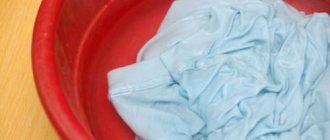A shrunken shirt is a nuisance that anyone can face. It occurs due to non-compliance with the rules for washing and caring for a shirt.
You should not rush to throw away an item. You can try to restore its size and shape at home.
What should I do if my shirt shrinks after washing, how can I return it to its original size? Find answers to your questions in the article.
Return of the lost form for products of different colors and materials
Depending on the fabric from which the shirt is made and its color, the methods for stretching it will differ. Recommendations are presented in the table:
| Shirt characteristics | How to effectively deal with shrinkage | Important Features |
| Cotton, linen | Hair conditioner | Do not wring out after washing |
| Wool, silk | Stretching with weights or in cold water | Do not use steam or chemicals |
| Synthetics | Freezing | Not picky fabric, all methods of exposure are suitable, but the item must be ironed at the lowest possible temperatures |
| Jeans | Pulling with weights or freezing | All processing methods are suitable, but since the fabric is rough, a significant effect cannot be achieved |
| White fabric | Hydrogen peroxide, milk, vinegar | Soak and dry separately from colored and black items |
| Colored fabric | Cold water, weight pulling, vinegar treatment | Soak and dry separately from white and black items |
| Black | Freeze, cold water | Soak and dry separately from white and colored items |
Twelve ways to stretch a shrunken shirt
- Soak the shrunken shirt in cool water at a temperature of up to 30 degrees for ten minutes. Then take it out and, without squeezing, lay it out in a horizontal position. When the water has drained, transfer the clothing to a terry towel or sheet and leave at room temperature until completely dry. During the drying process, you periodically need to stretch the fabric in the right directions. This is a universal method that will help stretch any material, including products made from natural and synthetic fabrics, silk and woolen items;
- You can soak a natural cotton shirt for ten minutes in cool water and then put it on yourself, walking until the clothes are completely dry. As a result, it will stretch across the body to the desired size;
- Add one or two tablespoons of hydrogen peroxide to cool water with a temperature of about 30 degrees. Soak clothing in the mixture for one to two hours. Then put the shirt on yourself and wear until completely dry, or lay the product on a horizontal surface and leave to dry naturally. At the same time, periodically stretch the material in the right directions;
- Pour three tablespoons of ammonia, a tablespoon of vodka and a tablespoon of turpentine into five liters of water with a temperature of up to 30 degrees. Leave the product in this solution for half an hour, then rinse in clean water at the same temperature and send to dry on a horizontal surface, after placing a terry towel. While drying, periodically stretch the shrunken areas. Hydrogen peroxide and alcohol-containing solutions make the fabric more elastic;
- A white shirt can be soaked in milk for half an hour. After the procedure, rinse the product in clean water at room temperature and send it to dry horizontally, placing it on a terry sheet or towel;
- To stretch a slightly shrunken shirt, sweater or T-shirt at home, turn the garment inside out and lay it out on an ironing board. Place damp cotton cloths or gauze on top. Steam the clothes with an iron at a distance of 10-15 centimeters from the surface, while stretching the shrunken areas, or iron the fabric with a warm iron, if the type of material allows it;
- To stretch the sleeves, hang a small weight on the wet item. In the same way, you can increase the length of the product. This method is suitable for shirts made of cotton and jersey, viscose and wool;
- If clothes made of cotton or knitwear have shrunk, a home method using hair conditioner will also help. To do this, soak the clothes in warm water at a temperature of 30-40 degrees for several minutes and squeeze lightly. Place the product in an empty container, thoroughly moisten it with hair conditioner and begin to stretch the material with your hands. After this, rinse in clean water at approximately the same temperature as the water in which the clothes were soaked, and leave the item to dry at room temperature;
- To stretch a cotton, wool or knit shirt, use 3% vinegar. To do this, lay out the item, soak a sponge in vinegar and start wiping the clothes, while stretching the desired areas. After this, wash the items in the washing machine on a cycle suitable for the fabric and rinse with bleach added to remove the unpleasant smell of vinegar;
- You can also soak your clothes in a vinegar solution. To do this, mix cool water with a 3% vinegar solution at the rate of three tablespoons of vinegar per ten liters of water. Soak the shirt for two to three hours, then wash and rinse as usual. When rinsing, you can add conditioner to eliminate the unpleasant smell of vinegar;
- Polyester clothing should be soaked in cold water for ten minutes and then washed in a washing machine on a delicate cycle at 20 degrees using wool powder;
- Clothing made from mixed fabrics stretches in the washing machine. Soak the items in cool water for 15 minutes, then place in the drum without powder or other detergent. Choose a gentle or delicate wash cycle. After the procedure, hang the shirt on a hanger with soft hangers and leave to dry naturally. During the drying process, periodically stretch the shrunken areas.
Important Tips
In order to avoid completely ruining your shirt when trying to stretch it, you need to take into account the following recommendations:
To cope with the problem, the product should be stretched while drying. However, the tension force must be controlled so as not to damage the fabric.- Before soaking an item in a chemical, you need to test it on an inconspicuous area of the fabric.
- The product should not be thrown over a rope. Such drying neutralizes the entire effect of the manipulations performed.
After returning the shirt to its original size, you must follow the manufacturer's instructions for caring for it. Otherwise, the next incorrect wash will cause it to shrink again.
How to prevent shrinkage
If you properly care for the item, it will not shrink. First of all, follow the washing regime and wash on a delicate cycle with a water temperature of up to 30-40 degrees. Try to wash and rinse in water at the same temperature. Due to sudden changes, the fabric can become deformed, decrease in size and shrink. For washing, choose appropriate powders, gels or shampoos. Separate items by fabric type and color.
Items made of wool and 100% cotton will definitely shrink after one or three washes, so it is better to buy clothes made from such materials a size larger. Dry clothes horizontally, spread out on a terry towel or sheet. Then it will not sit down, stretch out or become deformed. In addition, the item does not have to be ironed.
When the shirt is dry, hang the item on hangers and put it in the closet. Do not dry things near or on a radiator, in direct sunlight or near electrical appliances! This also causes shrinkage and deformation of materials.
To prevent the item from becoming deformed or wrinkled on the road, it is important to fold your clothes correctly. To fold a shirt or shirt, the product is placed face down. The sleeve is bent at the shoulder and half of the shirt is folded lengthwise towards the middle.
The same is done with the other sleeve and the second half. Then the lower part of the product is wrapped towards the cuffs and folded so that the lower edge lies against the collar. How to properly and compactly pack things for a trip, see here.
Which fabrics can be restored after improper washing?
Fabrics made from natural materials such as wool, cotton and their mixtures with synthetics are most susceptible to shrinkage. While cotton clothes are quite easy to shape, woolen fabrics require a fair bit of fiddling. That is why it is strongly recommended to use the most gentle mode for washing such items, and it is better to wash them by hand. In this case, it is necessary to use only lukewarm water, since the item often shrinks due to exposure to hot water.
Sewing the sleeves
If there is a need to change the sleeve size by 3-5 mm, the cutting diagram will be quite simple:
- Step 1. Turn the product inside out and straighten the seam.
- Step 2. Measure the required distance and draw a line where you want to make a new seam.
- Step 3: Sew a new line and trim off any excess fabric.
Since the material is cut on both sides, only allow half the distance from the seam. For example, if you need to trim 5 mm, set aside 2.5 mm.
Reducing shoulder width
The product is wide at the shoulders and is not difficult to reduce to the desired size. If the shirt is not too large, then it can be sewn in without ripping.
Without ripping
- Measure the length from the collar to the end of the shoulder, mark.
- From this mark, draw a line with chalk to the armpit along the front and back.
- Cut the fabric along the drawn line, leaving an allowance.
- Pin the top of the cut piece to the end of the shoulder line.
- Baste with back and shelf. The size of the armhole has become larger, so it needs to be reduced. The reduction is described above in the text
- Sew the joined parts and iron them.
Repair with ripping
- Use a seam ripper to cut out the sleeves.
- Determine the length of the shoulder, draw with chalk on the fabric. Check symmetry.
- Cut off the excess fabric, connect the sleeves to the back and front, and sweep. If the sleeve does not coincide with the reduced armhole, then it should also be sutured.
- Double stitch.
What to do if the shirt is too big in all respects? It is necessary to complete all stages in turn. First sew in the shoulders, then the armholes, then along the side seams. Then shorten and sew in the sleeve.
The last step is to shorten the shirt. It is necessary to mark the desired length, bend the fabric 2 centimeters, and baste. Then iron it, make another fold, iron it, and sew it on a machine. A woman's shirt can be hemmed on the arms.
Shortening the sleeves
In order to reduce sleeve length, careful measurements must be taken. Remember that the optimal length is determined by the bottom edge of the cuff: it should reach the bone that attaches the thumb to the hand.
There are several shortening options:
- First, you need to rip off the cuff and leave the folds intact using pins. Then measure the distance you need to cut. After trimming the excess fabric, sew the cuff back to the sleeve.
- Unpick the cuff and the elements that cover the cut on the sleeve. Measure the slot of the spline, mark a new one and make a cut for it. Make a triangular cut at the top of the slots, cut off the excess material at the bottom of the product. Pay special attention to the design of the corners of the cuff. Finish the cut, starting with the narrow element. Sew one surface of the cuff, not forgetting the folds on the sleeve. Then sew the second surface.
The second method is more labor-intensive and requires certain sewing skills.
If you want to shorten your sleeve size by more than 2 centimeters, do not try to simply cut off the excess fabric. This will reduce the size of the vent and make your shirt unattractive. In this case, you need not only to cut the material, but also to completely redo the slot.
Required Items
Before starting work, you should prepare all the necessary tools so as not to be distracted from the process.
You will need:
- needle;
- 15-20 pins;
- threads of a suitable color;
- sharp scissors;
- soap or colored chalk;
- sewing machine. It will greatly facilitate the process;
- measuring tape.
What can you do with shrunk socks and mittens?
Such a misfortune is doubly unpleasant if it happens in severe winter, and socks or mittens that have become smaller after washing are the only ones. To help the grief, you will need:
- vinegar;
- spray;
- many newspapers;
- any strong clips or clothespins.
- Soak things in water (you can add hair balm).
- Stretch them a little with your hands.
- Remove and squeeze without twisting.
- Spray wet items with vinegar from a spray bottle.
- Place more crumpled newspapers inside and secure the edges of the cuffs with clothespins to prevent the newspapers from falling out. You will have to change the paper sometimes, and the more often you can do this, the faster everything will dry. The smell of vinegar disappears quite quickly.
Woolen items are useful to wear for people suffering from rheumatism, osteochondrosis, orthopedic diseases and circulatory disorders.
Vinegar and crumpled newspapers will help restore the shape and size of mittens or socks made of wool.
How to make something shrink
But sometimes you may encounter a problem when clothes, on the contrary, stretch and become too big. In this case, the products must be washed or soaked in hot water. So the shirt can first be soaked in hot water at a temperature 20 degrees higher than indicated on the label. After this, wash your clothes as usual. To enhance the effect, dry the item on the radiator.
Cotton items can be washed in hot water or spun at high speed. Alternatively, you can immerse the washed item in boiling water and leave for five minutes. As a result, clothes will shrink one or two sizes, but colored fabrics may lose color and fade.
We looked at how to stretch and, conversely, shrink a shirt. How to stretch a shrunken dress, read the link.











